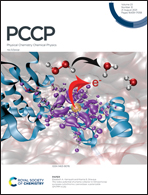Simulated Raman spectra of bulk and low-dimensional phosphorus allotropes†
Abstract
We present a comprehensive theoretical and experimental Raman spectroscopic comparative study of bulk Phosphorus allotropes (white, black, Hittorf's, fibrous) and their monolayer equivalents, demonstrating that the application of the Placzek approximation to density functional theory calculated frequencies allows reliable and accurate reproduction of the bulk spectra at a relatively low computational cost. As well as accurate frequencies, peak intensities are also reproduced with reasonable accuracy. Having established the viability of the method we apply it to other less well characterised phosphorus forms such as isolated P4 cages and the planar blue-phosphorus phase. There are several speculative structural models in the literature for amorphous red phosphorus, and we predict Raman spectra for several of these. Via comparison with experiment this allows us to eliminate many of them such as the P2P2-zigzag chain and connected P4 models. The combination of Density functional theory (DFT) modelling, Placzek approximation for intensities with experimental Raman spectroscopy is demonstrated as a powerful combination for accurate characterisation of phosphorus species.

- This article is part of the themed collection: 2021 PCCP HOT Articles


 Please wait while we load your content...
Please wait while we load your content...